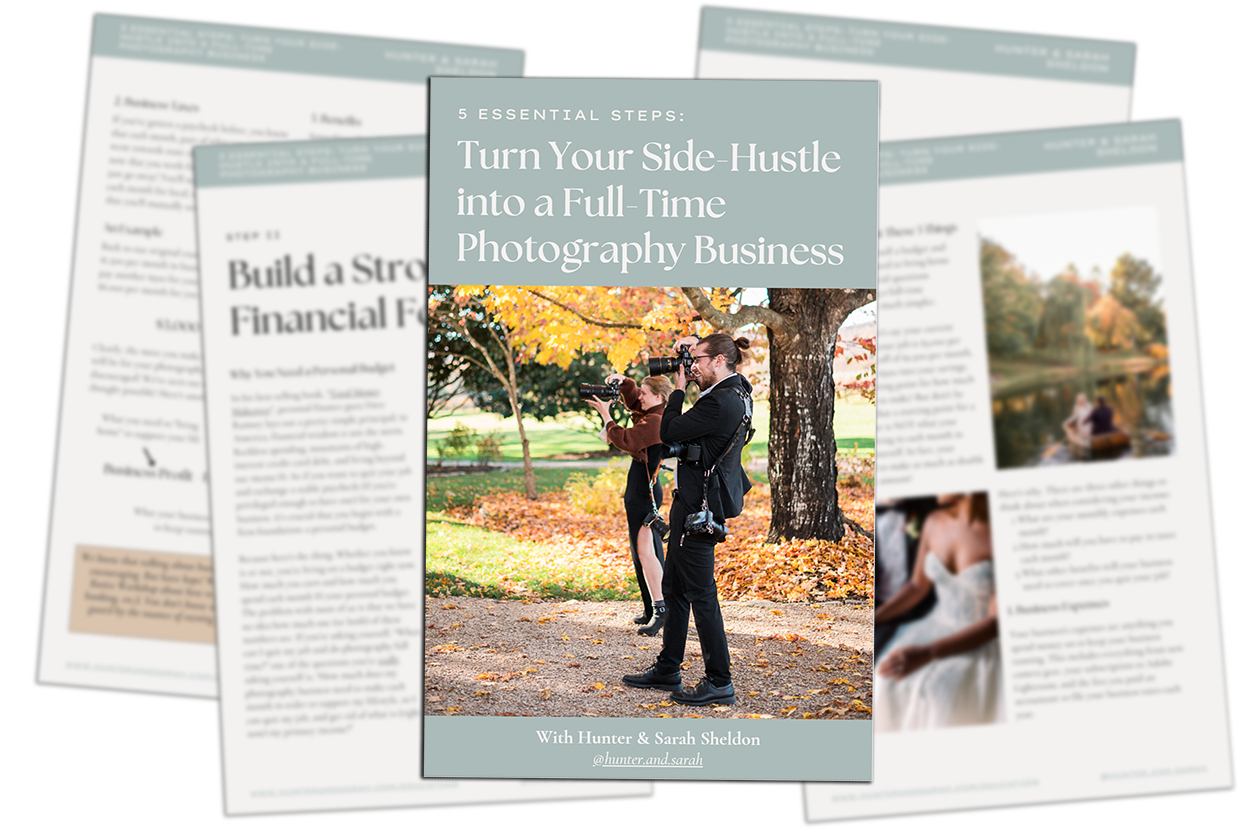VIEW BY CATEGORY:
Hi, we're Hunter and Sarah, a husband-and-wife, luxury wedding photography team. We’re also educators, helping other photographers build profitable and sustainable photography businesses.
MEET US
LOOKING FOR SOMETHING?

How to Officially Start a Photography Business 6
April 22, 2020
Hey Photographers! Earlier this Spring, we wrapped up a blog series aimed at something that consumes so much time and energy from wedding photographers: post production! If you missed it, Part 1 is here. This week, we’re introducing a new series that caused us SO much headache in the early days of our business: How to Officially and Legally Start a Photography Business!
Once you start making some real money with your photography, you may want to consider establishing a legal business entity. For the sake of organization, liability, legitimacy and tax-efficiency, this is the direction many photographers will go after a year or two of making money. And if you hope to go full-time in your photography one day, you’ll need to do this sooner or later!
Although establishing a business can seem like a daunting task, it’s actually more simple than it seems. Follow the steps in this blog series to go from side-hustler to business-owner!
How to Officially Start a Photography Business 6: Prepare For (And Pay) Self-Employment Taxes
This week we’re introducing the sixth and final installment in our getting-started-series, and it’s about the question we get most often from new photographers: “How do I pay taxes?!” And if you’ve never asked yourself this question, this blog is especially for you. It’s much better to be ahead of the curve than have the IRS knock on your door one day! While we do NOT claim to be accountants so this can’t be considered professional advice, this should help any small photography business just getting started with paying taxes!

Before You Pay Taxes You Must…
In order to get to the point that you even can pay taxes, you need to have completed the majority of the steps so far in this blog series. You at least need to have established a legal business and gotten your EIN from the federal government (Part 2). And it would certainly help if you had your own business bank account (Part 4)!
But just as important as both of those steps is this: you absolutely need to have started keeping track of your business finances (Part 1). How else will you know much you might owe?! This is absolutely crucial, and no real business can survive without having a strong grasp on your business finances. When it comes time to pay your federal and state income and self-employment taxes (more on the difference in a moment), this step is absolutely essential.
And like we mentioned all the way back in Part 1, if you’re in the very early stages of your business and don’t have many jobs or expenses, a simple spreadsheet might be fine to track your expenses. But once you start growing into a real, thriving business, an accounting software like Quickbooks is essential!

What’s the Difference Between Income Tax and Self-Employment Tax?
Let’s start by explaining the difference between federal income tax and self-employment tax. When you work for a company as a full-time or part-time employee, you get a paycheck once or twice a month. When you look at your pay stub, it tells you that you originally made some amount, then the government withheld a portion of that. If you looked closely, you’ll have realized that the government kept 6.2% of your paycheck for Social Security and 1.45% for Medicare, for a total of 7.65% of your paycheck. What you might not have realized, is that your employer was paying that exact same amount on your behalf!
In reality, you were splitting Social Security and Medicare taxes (together called FICA) with your employer! So now that you’re self-employed, you get to pay both halves! 😫 This means you’ll owe not just 7.65%, but 15.3%. So for every $100 you make, you owe the government $15.30 no matter how much you make that year. But that doesn’t include federal and state income tax. These are what people are talking about when they talk about “tax brackets”. While all self-employed individuals pay that 15.3%, how much you pay in income tax will depend on how much you make.
The numbers can change year-to-year, they’re what’s called “progressive”, and they depend on the income of your entire household, so your spouse’s income will be important here if you’re married. All that’s to say: your income tax can be another hefty tax if your photography business and/or your spouse’s income (combined) are relatively high. We won’t give specifics for you since everyone’s situation is different, but it’s best to do some research and consult an expert to know exactly how much you’ll owe. Since our photography business makes six-figures, our self-employment and federal income tax are combined at over 33%!

How Do I Pay Income and Self-Employment Tax?
If you’ve ever worked for a company, you know that both your FICA and your federal and state income taxes were withheld from your paycheck each week or each month. You didn’t have to do anything, and the money was set aside each time you got paid. When you’re self-employed, things are quite different! You actually need to calculate how much you owe, then pay it directly to your state and federal government every three months. These are called your “1040-ES Quarterly Estimated Payments”, and they can be paid online. We set aside that money each month so we don’t get to the end of a quarter and suddenly wonder where the money will come from!
How much should you pay each month in taxes? This is where things can get complicated. Again, if you don’t make much money and your finances are fairly simple, you can always estimate your tax bracket and add 15.3% to that to get a rough estimate of your tax percentage. Then, multiply that by your gross income from the quarter (income minus expenses). If that sounds complicated, here’s an example. If we took in $30,000 in income and had $10,000 in business expenses from January through March of this year, then our gross income is $20,000 ($30k – $20k). From that, we can use the IRS’s tax brackets to estimate that our tax bracket will be 22%, and we know that FICA will be 15.3%. So we multiply $20,000 by 37.3% (22% + 15.3%), and get $7,500. That’s how much we would pay for that quarter.
While this is a way to be “safe” and avoid underpayment penalties, you’ll almost certainly overpay your taxes if you use this method. And although you’ll get that money back when you get your tax return the following April, you’ve just given the federal government an interest-free 12-month loan with your money! We won’t get into how “progressive” tax brackets work, but a 22% bracket really is more like a 12%-18% rate. Not to mention, there are all sorts of deductions that a family and business can make. So how do you actually know how much you should pay? The answer is easy…

Hire an Accountant!
Here’s the deal: we understand some of these accounting basics because early in our business, we had to. But we are BY NO MEANS tax experts. And honestly, we made SO many mistakes in the early years of our business, and some of them ended up costing us thousands of dollars. Our first year in business, we expected a nice little tax return come April, only to find that we owed almost $4,000! As a newly-married couple with a fledgling business, that almost drained our savings. Since then, we’ve work with a professional accountant to help us make our quarterly estimated payments and file our business and personal taxes each April.
Although a professional accountant can be expensive, you can also find smaller, local accounting firms who are eager to take on new clients and will work with you since your business is relatively small. Although a good accountant will cost you (at least) $1,000 or more each tax season, once you make some money in your business, they’ll almost certainly save you far more than that! Bringing an accountant onto your team will not only take a huge burden off your shoulders, but will also save you money in the long run.
But finding an accountant isn’t always easy. We had three accountants in our first three years in business because we just couldn’t find the right fit. Our advice: meet with your accountant before you hire them and interview them. After all, they’re applying for a job to be your accountant! If they don’t seem like someone who is eager to be a part of your team, willing to learn and grow with you as your business develops, and will be available to you for the occasional question, you may want to keep looking. And if you don’t know where to start, why not chat with our accountant first! We’ve had a fantastic experience with the team at Smith, Going and Associates here in Charlottesville, and know that we’ve finally settled on our accountant for good.

Well, we hope that this series has been helpful to any new photographers out there! If you feel like we missed anything, or you’d like more information about this process, feel free to reach out to us! If you’re interested in learning more from us personally, and joining a community of other photographers also striving to grow their businesses, click here to join our Facebook Community, Mastering the Wedding Photography Biz with Hunter and Sarah!
Next week we’ll continue our For Photographers content, but for now, go get ’em, business owner!
Want More?
Click HERE to get your free copy of our eBook: “5 Essential Tips for Turning your Side-Hustle into a Full-Time Photography Business.” You’ll also be subscribed to our newsletter, so our newest content, weekly encouragement, and exclusive offers will be delivered right to your inbox!

—
Check out the other segments in this blog series!
- How to Officially Start a Photography Business 1: Start Keeping Track
- How to Officially Start a Photography Business 2: Establish an LLC
- How to Officially Start a Photography Business 3: Pay “Sales and Use” Tax Each Month
- How to Officially Start a Photography Business 4: Get a Business Bank Account
- How to Officially Start a Photography Business 5: Get Business Insurance
Filed in:
Wedding Photography & Photography Education
Charlottesville, Virginia and Beyond
HOME
ABOUT US
WEDDINGS
JOURNAL
FOR PHOTOGRAPHERS
PRESS & PRAISE
BLOG
CONTACT
e. hunter@hunterandsarahphotography.com
p. (434) 260-0902
